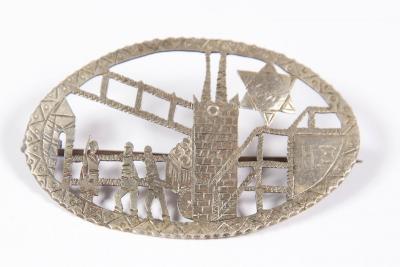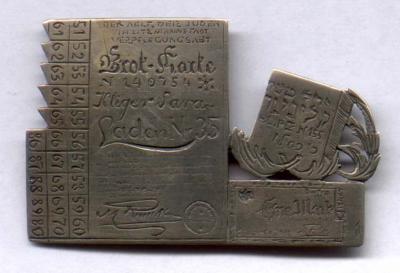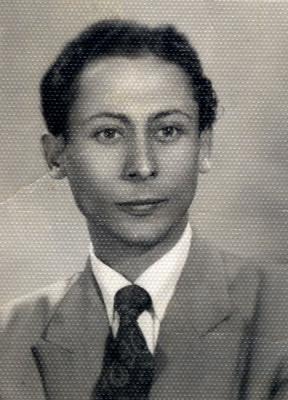The creating of small mementos that were engraved with depictions of life in the Lodz ghetto, was one of the ways in which those enclosed within the ghetto were able to express some sense of freedom. The items are a testament to the high degree of technical ability and artistic talent of their creators. The subjects depicted on the engraved metal items can be found in drawings and photographs that document life in the Lodz ghetto.
A number of artifacts of this kind from the Lodz ghetto are included in the Artifacts Collection:
Bracelet
A bracelet made of five links, depicting scenes of life in the ghetto: transporting loaves of bread in a wagon pulled along by two people, the spire of the Catholic church that stood next to the wooden bridge of the ghetto, a guard standing next to his booth at the entrance of the ghetto, the workers whose task it was to pull the wagon carrying the sewage of the ghetto. The central link is engraved with the initials “G.F.” as well as the date 30th August, 1943.
Yad Vashem Artifacts Collection
Gift of Shmuel Barash, Netanya, Israel
Oval Brooch
The brooch was apparently crafted by an artist whose initials are H.S. Depicted are the bridge of the ghetto, the yellow star, the Catholic church next to the ghetto, the bread distribution in the ghetto and the guard at the ghetto’s entrance.
Yad Vashem Artifacts Collection
Gift of Shmuel Barash, Netanya, Israel
Brooch in the Shape of a Bread Ration Card
The craftsman Chaim Klieger made the brooch for his younger sister Sara in the Lodz ghetto. The brooch is designed as a bread ration card issued to Sara Klieger with a tiny Lodz ghetto banknote attached. Above them is a replica of the grave of Idel Moshe Klieger, their father.
Chaim Klieger spent much of his childhood in his father’s workshop. His father was an independent and successful mechanic who fixed machinery in the numerous factories in Lodz. In conjunction with his studies at high school, Chaim studied drawing and graphics, and learned the skills of a silversmith.
After the outbreak of war, Chaim was enclosed in the ghetto along with his parents Chana and Moshe, and his four sisters: Rosa, Bluma, Sara and the youngest, Esther, who was born in 1931.
Moshe Klieger opened a small workshop in the ghetto, manufacturing wool socks for the German army. The whole Klieger family worked there, including Esther. Later, Moshe established a second workshop for metalwork. The women continued working in the socks workshop and Chaim worked in the metal workshop. Using the raw materials gleaned from aircraft pieces and other bits of metal, Chaim would make small items like combs, brooches and medallions. Many of these items depicted scenes from ghetto life. Chaim would barter these items in exchange for food.
Until the summer of 1944, the family’s work protected them from deportation to the camps. However, they still suffered from the appalling conditions in the ghetto, and both Moshe and his daughter Rosa perished there.
In August 1944, Chaim, his mother and remaining sisters were deported to Auschwitz. Esther managed to lie about her age and survived the selection with her sisters, but Chana was sent to her death. Chaim was assigned to forced labor with the men.
The three sisters did what they could to remain together and help each other. The brooch that Chaim had made was kept by them, hidden in rags, in pieces of soap and sometimes between their fingers. On one occasion the sisters were sent to the gas chambers, but they were saved by a technical hitch. Instead, they were sent to the Stutthof camp.
The harsh living conditions and the exhausting work the women were forced to do resulted in the deterioration of the sisters’ health. Bluma and Sara died a few days apart from each other, and Esther, left to survive alone, now prayed for death, but held on to her last family memento - the brooch that Chaim had crafted for Sara.
After liberation, in a state of exhaustion and only partially conscious, Esther was transferred from the camp for convalescence. In spite of her condition, when she felt that her prison dress was being removed and thrown into the fire, she jumped up and grabbed the brooch, saving it as the last link to her family.
At the end of May 1945, the Swedish Red Cross transported youngsters who had survived, among them the fourteen-year-old Esther, to Sweden to convalesce. On the ship she met an acquaintance of her brother who told her that Chaim had survived, but when she was able to return to Poland, she discovered that he had already left the country and that no other family members had survived.
Chaim had left Poland for Italy, with the intention of immigrating to Eretz Israel. In Rome he was active in the “Bericha” movement and used his technical abilities to forge permits to enter Eretz Israel. Unfortunately, due to his poor physical condition he could not get a permit for himself, and eventually he immigrated to Brazil. Only a year after the war ended did Chaim learn that his sister Esther had survived the war, but the two were only able to correspond by mail until Chaim’s death in 1956.
In 1957, Esther immigrated to Israel with her husband and daughter. Like her brother, Esther was blessed with artistic talent and her paintings have been donated to several Holocaust museums, including Yad Vashem and the United States Holocaust Memorial Museum in Washington.
Yad Vashem Artifacts Collection
Brooch - Gift of Esther (Klieger) Shlamovitch, Holon, Israel
Oval Brooch, Bracelet - Gift of Shmuel Barash, Netanya, Israel










